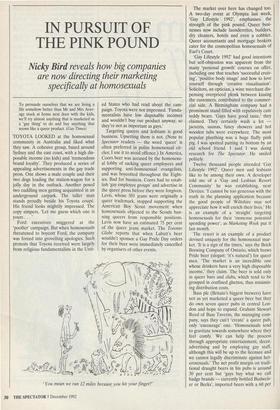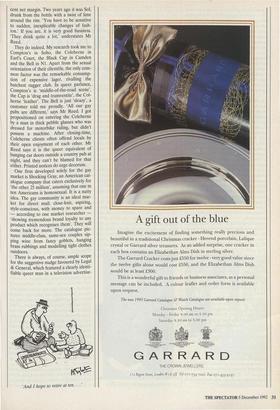IN PURSUIT OF THE PINK POUND
Nicky Bird reveals how big companies are now directing their marketing specifically at homosexuals To persuade ourselves that we are living a life somehow better than Mr and Mrs Aver- age stuck at home next door with the kids, we'll try almost anything that is marketed as a 'gay thing' to do and buy anything that seems like a queer product. (Gay Times)
TOYOTA LOOKED at the homosexual community in Australia and liked what they saw. A cohesive group, based around Sydney and the east coast, with a high dis- posable income (no kids) and 'tremendous brand loyalty'. They produced a series of appealing advertisements in the gay trade press. One shows a male couple and their two dogs loading the station-wagon for a jolly day in the outback. Another posed two cuddling men getting acquainted in an underground carpark. The taller man stands proudly beside his Toyota coupe. His friend looks mightily impressed. The copy simpers, 'Let me guess which one is yours . . . '
Ford executives sniggered at the `poofter' campaign. But when homosexuals threatened to boycott Ford, the company was forced into grovelling apologies. Such protests that Toyota received were largely from religious fundamentalists in the Unit- ed States who had read about the cam- paign. Toyota were not impressed. 'Funda- mentalists have low disposable incomes and wouldn't buy our product anyway, so they're not as important as gays.'
Targeting queers and lesbians is good business. Upsetting them is not. (Note to Spectator readers — the word 'queer' is often preferred in polite homosexual cir- cles; I use it to avoid offence.) In America, Coors beer was accused by the homosexu- al lobby of sacking queer employees and supporting anti-homosexual evangelists, and was boycotted throughout the Eight- ies. Bad for business. Coors had to estab- lish 'gay employee groups' and advertise in the queer press before they were forgiven. Levis, whose 501 jeans were originally a queer trademark, stopped supporting the American Boy Scout movement when homosexuals objected to the Scouts ban- ning queers from responsible positions. Levis now have an estimated 75 per cent of the queer jeans market. The Toronto Globe reports that when Labatt's beer wouldn't sponsor a Gay Pride Day orders for their beer were immediately cancelled by organisers of other events.
'You mean we ran 12 miles because you hit your finger?'
The market over here has changed too. A two-day event at Olympia last week, 'Gay Lifestyle 1992', emphasises the strength of the pink pound. Queer busi- nesses now include launderettes, builders, dry cleaners, hotels and even a cobbler. Queer accountants and mortgage brokers cater for the cosmopolitan homosexuals of Earl's Court.
'Gay Lifestyle 1992' had good intentions but self-obsession was apparent from the many 'personal growth' courses on offer, including one that teaches 'successful cruis- ing', 'positive body image' and how to love yourself through `creative visualisation'. Solicitors, an optician, a wine merchant dis- pensing overpriced plonk between kissing the customers, contributed to the commer- cial side. A Birmingham company had a prominent stand filled with repulsively cute teddy bears. 'Gays have good taste,' they claimed. They certainly wash a lot — jacuzzis, saunas, fancy showers and hot wooden tubs were everywhere. The most popular plaything was a huge fluffy pink pig. I was spotted patting its bottom by an old school friend. I said I was doing research for The Spectator. He smiled politely.
Twelve thousand people attended 'Gay Lifestyle 1992'. Queer men and lesbians like to be among their own. A developer told me of a `Gay and Lesbian Resort Community' he was establishing, near Devizes. 'I cannot be too generous with the truth in the planning application because the good people of Wiltshire may not appreciate how it will enrich their lives.' He is an example of a 'straight' targeting homosexuals for their `immense potential spending power', as Marketing Week put it last month.
The resort is an example of a product devised uniquely for the homosexual mar- ket. 'It is a sign of the times,' says the Brick Brewing Company of Ontario, which brews Pride beer (slogan: It's natural') for queer men. `The market is an incredible one whose drinkers have a very high disposable income,' they claim. The beer is sold only in queer bars and clubs, which tend to be grouped in confined ghettos, thus minimis- ing distribution costs.
Bass plc (Britain's biggest brewers) have not as yet marketed a queer beer but they do own seven queer pubs in central Lon- don and hope to expand. Graham Stewart Reed of Bass Taverns, the managing com- pany, says they can't `create' a queer pub, only 'encourage' one. 'Homosexuals tend to gravitate towards somewhere where they feel comfy. We can help the process through appropriate entertainment, decor, advertising and by employing gay staff, although this will be up to the licensee and we cannot legally discriminate against het- erosexuals.' The net profit margin on tradi- tional draught beers in his pubs is around 30 per cent but 'gays buy what we call badge brands — currently bottled Budweis- er or Becks', imported beers with a 60 per
cent net margin. Two years ago it was Sol, drunk from the bottle with a twist of lime around the rim. 'You have to be sensitive to sudden, inexplicable changes of fash- ion.' If you are, it is very good business. 'They drink quite a lot,' understates Mr Reed.
They do indeed. My research took me to Compton's in Soho, the Coleherne in Earl's Court, the Black Cap in Camden and the Bell in Ni. Apart from the sexual orientation of their clientele, the only com- mon factor was the remarkable consump- tion of expensive lager, rivalling the butchest rugger club. In queer parlance, Compton's is 'middle-of-the-road scene', the Cap is 'drag and transvestite', the Col- herne 'leather'. The Bell is just 'sleazy', a customer told me proudly. 'All our gay pubs are different,' says Mr Reed. I got propositioned on entering the Coleherne by a man in thick pebble glasses who was dressed for motorbike riding, but didn't possess a machine. After closing-time, Coleherne clients often offend locals by their open enjoyment of each other. Mr Reed says it is the queer equivalent of banging car doors outside a country pub at night, and they can't be blamed for that either. Printed notices do urge decorum.
One firm developed solely for the gay market is Shocking Gray, an American cat- alogue company that caters exclusively for 'the other 25 million', assuming that one in ten Americans is homosexual. It is a natty idea. The gay community is an ideal mar- ket for direct mail: close-knit, aspiring, style-conscious, with money to spare and — according to one market researcher — 'showing tremendous brand loyalty to any product which recognises them'. They will come back for more. The catalogue pic- tures middle-class, same-sex couples sip- ping wine from fancy goblets, hanging brass rubbings and modelling tight clothes outdoors.
There is always, of course, ample scope for the suggestive nudge favoured by Legal & General, which featured a clearly identi- fiable queer man in a television advertise- 'And I hope to retire at ten. . ment showing happy customers queuing. Such discreet signals can be effective. Oth- ers prefer a more direct appeal, like Calvin Klein, Remy Martin and Penguin Books, who advertise in homosexual house jour- nals. Remy has wooed the queer commu- nity so energetically that it is now their favourite noggin. Penguin are expanding their list of queer fiction and verse because, as the editor explained, 'If two novels of comparable quality were being considered for publication — one "straight", one gay — I would choose the gay title because there is always a solid bedrock of sales that underpin the edition. It is a commercial decision.'
In Britain, Absolut Vodka have chased the pink pound with a campaign in the queer press featuring blatant phallic imagery. St Ivel use the screamingly camp Julian Clary in a television advertisement that stars a very long cucumber teased by smaller ones; but 'silly names don't hurt this strapping young cucumber' because he can 'hog' more St Ivel than the little chaps. The advertisers report that housewives find the double entendre 'both funny and appropriate'.
The market research that confirmed the strategy of targeting homosexuals was car- ried out by a Chicago firm called Over- looked Opinions in 1988 (no British research into the living and spending habits of the community appears to exist). Some interesting facts emerged: *Annual gay market in US: $514 billion (disposable income).
*Favourite cereal: Cheerios.
*Gays use Amex gold cards 4.6 times more than others.
*Gays travel 5.6 times above the average. *Favourite magazine for men: Newsweek; for women: People.
*Favourite sweet: Snickers.
*Gay men prefer dogs to cats, Judy Gar- land to Micky Rooney.
*87 per cent of gays voted in the 1988 elec- tion (others 50 per cent).
Dubious research possibly, although the sample was 25,000. But it did show that gay couples were younger, richer and bet- ter educated than 'straights': and, signifi- cantly, that they overwhelmingly bought by brand name.
Last month's Gay Times featured a polemic on the pink economy from the queer corner, which argued that gays buy their lifestyle both to identify themselves and, in a hostile world, to prove they exist: 'There is a Pink Economy . . . [we] make common purchase decisions . . . and remain image-conscious well into middle age . . . we'll try out any new and trendy products to stop us getting bored.'
Marketing Week considers it the last untapped market of capitalism. And as a friend from Saatchi & Saatchi told me, 'An employed fashion-conscious consumer who goes on lots of holidays, doesn't pay school fees and throws things away before they're bust is an adman's dream.'












































































 Previous page
Previous page